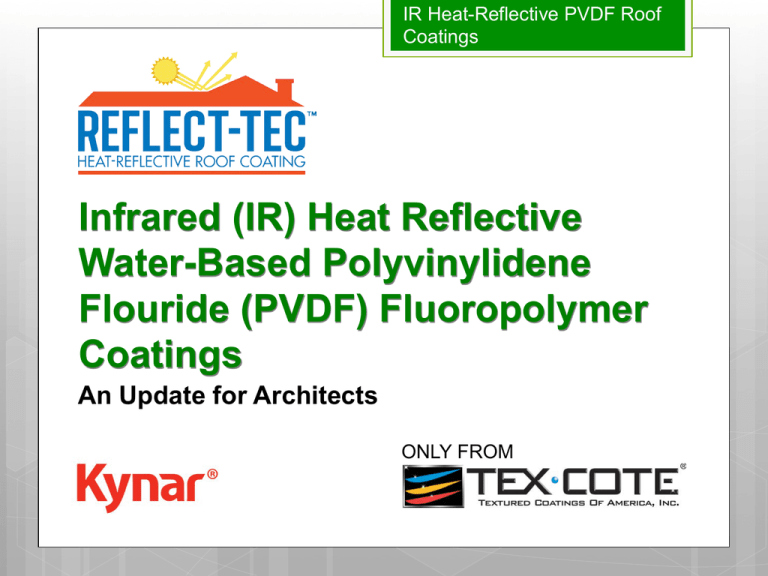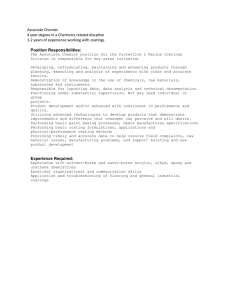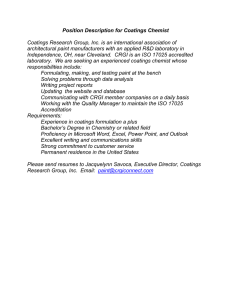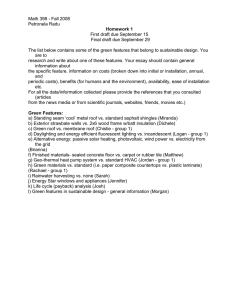
IR Heat-Reflective PVDF Roof
Coatings
Infrared (IR) Heat Reflective
Water-Based Polyvinylidene
Flouride (PVDF) Fluoropolymer
Coatings
An Update for Architects
ONLY FROM
IR Heat-Reflective PVDF Roof
2
Coatings
An Update for Architects
Textured Coatings of America, Inc. is a Registered Provider with The
American Institute of Architects Continuing Education Systems (AIA/
CES). One (1) Health, Safety, and Welfare/ Sustainable Design Learning
Unit (LU/HSW/SD) Hour earned on completion of this program will be
reported to AIA/CES for AIA members. Certificates of Completion for
both AIA members and non-AIA members are available upon request.
Please be sure to sign in to receive credit.
This program is registered with AIA/CES for continuing professional
education. As such, it does not include content that may be deemed or
construed to be an approval or endorsement by the AIA of any material
of construction or any method or manner of handling, using,
distributing, or dealing in any material or product.
Questions related to specific materials, methods, and services will be
addressed at the conclusion of this presentation.
IR Heat-Reflective PVDF Roof
3
Coatings
Copyright Materials
This presentation is protected by US and International copyright laws.
Reproduction, distribution, display and use of the presentation without
the written permission of the producer is prohibited.
©2012 TEX•COTE® Textured Coatings of America, Inc. All Rights
Reserved. TEX•COTE® is a registered trademark of Textured Coatings
of America, Inc. REFLECT-TEC™ is a trademark of Textured Coatings of
America, Inc. Kynar® is a registered trademark of Arkema, Inc.
only from!
IR Heat-Reflective PVDF Roof
4
Coatings
Course Description
Infrared (IR) heat-reflective PVDF coating systems
for the tile and metal roofing surfaces of a
structure are an important technological
breakthrough. These water-based, field-applied
coatings offer new advantages and opportunities
in both residential and commercial applications.
This program will provide an overview of this
innovative coating technology, as well as an
update on key energy-saving standards.
IR Heat-Reflective PVDF Roof
5
Coatings
Learning Objectives
At the end of this program, participants will be able
to:
1. Define a “Cool Roof”
2. Define IR Heat-Reflective Field-Applied Roof
Coatings
3. Define PVDF Roof Coatings
4. Identify Uses and Benefits of Water-Based IR
Heat-Reflective Field-Applied PVDF Coating
5. Identify Green Building Programs That Require or
Offer Credit for Cool Roof Products
IR Heat-Reflective PVDF Roof
6
Coatings
What is a “Cool Roof”?
A “cool roof” is a roof
that reflects and emits
heat from the sun back
into the atmosphere
instead of absorbing it
into the building below.
The amount of “coolness” is measured by
both Total Solar
Reflectance (TSR) and
thermal emittance.
Arizona State University “Old Main” with IR
Heat Reflective Coating and over five years
exposure.
IR Heat-Reflective PVDF Roof
7
Coatings
What is a “Cool Roof”?
Reflectivity and Emissivity
There are two considerations when looking at the
energy efficiency of a
surface. They include
reflectivity and emissivity.
Reflectivity is a measure of
how well a material rejects
solar energy. Emissivity
refers to the degree that the
material holds that energy.
Lihue International Airport - Hawaii
IR Heat-Reflective PVDF Roof
8
Coatings
What is a “Cool Roof”?
Image courtesy of Cool Roof Rating Council
IR Heat-Reflective PVDF Roof
9
Coatings
What is an “IR Heat-Reflective
Roof Coating”?
Infrared (IR) HeatReflective Roof Coatings
are revolutionary
coatings formulated with
a special heat-reflective
finish that reflects
infrared heat back into
the atmosphere and can
greatly increase the TSR
values of new or existing
metal and tile roofing
structures in all colors.
IR Heat-Reflective Roof Coating - Hawaii
IR Heat-Reflective PVDF Roof
10
Coatings
Origin of IR Heat- Reflective
Coatings
IR Heat-Reflective
coatings originated
within the U.S. Military.
And more recently
utilized in their
STEALTH program
where they are used to
diffuse heat to
eliminate radar
detection.
IR Heat-Reflective
IR Heat-Reflective
IR Heat-Reflective PVDF Roof
11
Coatings
Development of IR HeatReflective Coatings
IR Heat-Reflective Coatings are…
u Designed to change the infrared or invisible
portion of the light spectrum, helping to reflect
heat. Therefore reducing heat absorption, even
in dark colors.
u Designed to diffuse heat evenly across the
roofing surface.
u Works without the use of ceramic
spheres or
other non-proven technologies.
IR Heat-Reflective PVDF Roof
12
Coatings
The Light Spectrum
Much of the light spectrum
consists of visible light –
the light we can actually
see. But a large portion of
it is invisible to the eye –
the near infrared light. IR
heat reflective coatings
reduce the effect of this
largest portion of the light
spectrum. By making this
portion of the light
spectrum highly reflective,
darker colors can perform
much like lighter colors.
IR Heat-Reflective PVDF Roof
13
Coatings
Dark Colors vs. Light Colors
Anyone who has ever owned a dark colored car in the
summertime knows that dark colors absorb more heat
from the sun than light colors. That’s because a color like
black reflects less of the sun’s energy than the color
white. In fact, black only reflects about 5% of the sun’s
energy. IR heat reflective coatings allow even dark colors
to act like light colors,
reflecting much of the
sun s radiant
energy… an important
advantage to
designers, builders
and building owners
concerned about rising
energy costs and
global warming.
IR Heat-Reflective PVDF Roof
14
Coatings
Materials and Heat Absorption
On a hot day, roof surfaces can absorb as much as 90% of the
radiant energy. Even white roofs can absorb significant solar
radiation. The roof’s absorption of radiant energy makes the
inside of the structure hotter and creates greater demand on
HVAC systems, thus contributing to carbon emissions.
Tests show that advanced infrared heat reflective coatings are
on average 100% more reflective than ordinary paint, even in
darker colors. When less heat enters a structure, less energy is
required to cool its interior.
IR Heat-Reflective PVDF Roof
15
Coatings
What is a “PVDF”
Fluoropolymer Roof Coating?
Water-based PVDF Fluoropolymer Roof Coatings
incorporate Polyvinylidene
Flouride (PVDF) resin
technology which provides
several increased benefits
as compared to typical
acrylic roof coatings. PVDF
coatings have a much
harder finish, providing
many benefits as compared
to typical acrylic/
elastomeric roof coatings.
IR Heat-Reflective PVDF Coating
applied to tile roof surface
IR Heat-Reflective PVDF Roof
16
Coatings
What They Can Do
Compared to typical acrylic and/or elastomeric roof
coatings and non-coated roofing surfaces, IR HeatReflective PVDF Roof Coatings can…
Greatly reduce the amount of heat that is absorbed
and retained by a building’s exterior roof surfaces.
u Lower exterior roof temperatures by over 50
degrees when compared to non-reflective coatings,
paints, and uncoated surfaces in many colors.
u Provide a
passive cooling technique that yields
peak cooling load reductions and carbon
reductions. Reduce the urban heat island effect,
which contributes to urban smog and causes
increased demands on power plants.
u
IR Heat-Reflective PVDF Roof
17
Coatings
What They Can Do (cont.)
Compared to typical acrylic and/or elastomeric roof
coatings and non-coated roofing surfaces, IR HeatReflective PVDF Roof Coatings can…
Reduce building fatigue by reducing expansion and
contraction due to heating and cooling cycles.
u Help prevent colors from fading due to UV light
exposure.
u Prevent reduction in TSR due to dirt pick-up.
u Resist mold and mildew growth leading to reduced
maintenance costs.
u Lead to longer air-conditioning unit life due to
reduced use.
u
IR Heat-Reflective PVDF Roof
18
Coatings
Features & Benefits
u
u
u
u
Aesthetic Appeal: Offers greater design
flexibility through use of dark colors.
Total Solar Reflectance (TSR) and Energy
Savings: Increased TSR, even in white color,
significantly reduces roof surface temperatures
while helping reduce peak cooling load.
Resistance to Dirt Pick-Up: Keeps coating
surface clean and prevents reduced Solar
Reflectance due to dirt pick-up, especially in
white!
Resistance to Mold/ Mildew Growth: Prevents
visual degradation, reduced TSR, and lowers
maintenance costs!
IR Heat-Reflective PVDF Roof
19
Coatings
Features & Benefits (Cont.)
u
u
u
Durability: Prevents moisture penetration,
reduces the effects of roofing structure fatigue
caused by expansion and contraction and
effectively extends the life cycle of existing
building stock.
Retention of Color and Gloss: Provides superior
resistance to fading as compared to
conventional paints – even in dark colors.
Reduced Environmental Impact: Exterior coating
is formulated with Low Volatile Organic
Compounds (VOC) that meet requirements
of green building rating systems such as
LEED® even as an exterior applied coating.
IR Heat-Reflective PVDF Roof
20
Coatings
Aesthetic and Style Choices
IR Heat-Reflective PVDF Coatings offer a wide
range of design choices…
u
u
u
Exhibit heat-reflective properties, even in
medium or dark colors, eliminating the
necessity to have a white roof to enjoy the
benefits of increased reflectivity.
Ability to use various colors to match or
complement wall and trim colors.
Semi-gloss finish that is not only visually
appealing but also contributes to resistance to
dirt-pickup and self cleaning properties.
IR Heat-Reflective PVDF Roof
21
Coatings
Total Solar Reflectance (TSR)
Definition:
The ratio of total solar
radiation which is reflected
outward by the surface to the
amount of total solar radiation
falling on the surface.
Traditional paint colors provide
limited heat reflective
properties. IR heat reflective
coatings enable high
reflectance, in ALL colors, even
white and dark. In fact, IR heat
reflective PVDF coatings are on
average 100% more reflective
than traditional paints and
coatings in the same color.
Additionally, they resist dirt
pick-up, which can accumulate
and reduce TSR over time.
IR Heat-Reflective PVDF Roof
22
Coatings
Solar Reflective Index (SRI)
Definition:
The Solar Reflective Index (SRI) incorporates both the
Total Solar Reflectance (SRI) and thermal emittance in to
one value. SRI is used by many codes, standard, and
programs that specify cool roofing requirements. A high
SRI value is synonymous with a cool roof.
Calculating SRI:
Lawrence Berkeley National Laboratory maintains a userfriendly SRI calculator on their website. Simply input the
Total Solar Reflectance and thermal emittance values and
the calculator will determine the SRI. This tool is located at
www.coolcolors.lbl.gov .
IR Heat-Reflective PVDF Roof
23
Coatings
Increased TSR, in ALL Colors!
Total Solar Reflectance - IR Heat-Reflective PVDF Coatings
% Increase TSR vs. Conventional Paint
0.38
0.40
217% 18%
0.12
0.34
0.42
0.44
0.47
250% 100% 104%
0.12
0.22
0.23
0.49
0.55
0.58
104%
90%
87%
0.24
0.29
0.31
Conventional Paint TSR
0.61
53%
0.40
0.68
31%
0.52
IR Heat-Reflective PVDF Roof
24
Coatings
Increased SRI, in ALL Colors!
Solar Reflective Index - IR Heat-Reflective PVDF Coatings
42
45
48
50
54
57
65
69
73
83
9
38
9
22
24
25
31
34
46
61
Conventional Paint SRI
IR Heat-Reflective PVDF Roof
25
Coatings
Estimated Increase in TSR
Total Solar Reflectance
IR Heat-Reflective
PVDF Coatings Color
Family
Estimated Increase in
Reflectivity vs.
Traditional Paint
Light
>30%
Medium
>100%
Dark
>200%
IR Heat-Reflective PVDF Roof
26
Coatings
Total Solar Absorption
Definition:
The ratio of the amount of
total solar radiation
absorbed by the surface to
the amount of total solar
energy falling on the
surface. Solar absorption is
that portion of total solar
radiation neither
transmitted nor reflected.
Because more solar radiation is reflected by IR heat reflective
PVDF coatings, the emittance value is higher. When less energy is
absorbed, the amount of heat entering the interior of a structure is
reduced. This reduction in heat means a reduction in the use of
HVAC systems to cool the interior, reducing peak cooling loads.
IR Heat-Reflective PVDF Roof
27
Coatings
Reduced Surface Temperatures
Increased Total Solar Reflectance obtained with IR Heat-Reflective
PVDF Coatings can lead to surface temperature reductions of over
50° F*.
Metal
Tile
Heat lamp demonstrations show surface temperature reductions of over 50° F
obtained with IR Heat-Reflective PVDF Coating when compared to traditional
acrylic paint in identical color on a metal surface (left) and over 70° F when
compared to uncoated tile (right) – even in a darker color!
IR Heat-Reflective PVDF Roof
28
Coatings
Reduced Peak Cooling Load
Depending on the climate zone, substrate & other
conditions in which a building is located, heat
reflective coatings can make a significant
contribution to reduce peak cooling load & lower
cooling costs. Heat reflective coatings can:
u Lower roof surface temperatures by over 50
degrees when compared to traditional paints
and uncoated roofing surfaces in many colors.
u Reduce energy costs related to peak cooling
load*.
u Create less heat buildup around the building
(heat island effect) that can raise interior
temperatures.
*Percentage of peak cooling load reductions are based on models generated from the “Roof Savings Calculator” Beta
Release v 0.92 Oak Ridge and Lawrence Berkeley National Laboratories when compared to a non-cool roof . Cooling
costs savings, percentage of peak cooling load and surface temperature reductions will vary based on color chosen,
geographical location, climate condition, and substrate type. In some climates, there may be a heating penalty. For
more information, see www.texcote.com.
IR Heat-Reflective PVDF Roof
29
Coatings
Estimated Reduction in Peak
Cooling Load*
IR Heat-Reflective PVDF Estimated Reduction in
Coatings Color Family
Peak Cooling Load
Light
20-30% (KWh)
Medium
15-25% (KWh)
Dark
10-20% (KWh)
*Percentage of peak cooling load reductions are based on models generated from the “Roof Savings Calculator”
Beta Release v 0.92 Oak Ridge and Lawrence Berkeley National Laboratories when compared to a non-cool roof .
Cooling costs savings, percentage of peak cooling load and surface temperature reductions will vary based on color
chosen, geographical location, climate condition, and substrate type. In some climates, there may be a heating
penalty. For more information, see www.texcote.com.
IR Heat-Reflective PVDF Roof
30
Coatings
Resistance to Dirt Pick-Up, Even in
White Colors
IR heat-reflective coatings that incorporate PVDF resin
technology exhibit superior resistance to dirt pick-up
as compared to typical acrylic paint.
Carbon Black
Powder (water
wash off)
Commercial Elastomeric
Acrylic Paint
PVDF Based Coating
Original Color
Iron Oxide
Slurry
IR Heat-Reflective PVDF Roof
31
Coatings
Aluminum Panels with White Coatings
in FL with 10 Years Weathering
unexposed
Exposed
Elastomeric
Acrylic
PVDF
IR Heat-Reflective PVDF Roof
32
Coatings
Extreme Resistance to Mold/
Mildew Growth
Water-based IR heat-reflective coatings that
incorporate PVDF resin technology exhibit
superior resistance to mold and mildew growth
as compared to typical acrylic/ elastomeric paint
and uncoated surfaces. Mold and mildew growth
on a roof surface can cause a reduction in Total
Solar Reflectance and increases maintenance
costs.
IR Heat-Reflective PVDF Roof
33
Coatings
Extreme Resistance to Mold/ Mildew
Growth
Before - Uncoated Tile
After
IR Heat-Reflective PVDF Roof
34
White Coatings
Less Dirt Pick-Up & Less Mold and
Mildew Growth Prevents TSR Reductions
Total Solar Reflectance
Typical acrylic/ elastomeric coatings experience a
reduction in TSR over time as dirt and other
contaminants build on the surface, even in white!
Water-based IR Heat Reflective PVDF Coatings resist
these contaminants and maintain a TSR of 0.78 after
10 years exposure. The TSR of typical acrylic/
elastomeric white coatings was reduced to 0.55 after
only 3 years in a study done by Lawrence Berkely
National Laboratory.
1
0.75
0.5
0.82
0.81
0.78
Initial
5 Years
10 Years
0.25
0
Maintains 0.78 TSR After 10 Years Exposure
IR Heat-Reflective PVDF Roof
35
Coatings
Durability
Most building materials, including roof surfaces
and substrates, are prone to expansion and
contraction due to natural heating and cooling.
Excessive heat absorption can exacerbate this
natural expansion and contraction, placing
stress on the substrate and causing building
fatigue.
Because of the high reflectance properties of
these coatings, the amount of heat absorbed by
the substrate is greatly reduced. The result:
u
u
u
Less expansion and contraction.
Less stress placed on the substrate.
Increased life-cycle performance.
IR Heat-Reflective PVDF Roof
36
Coatings
Superior Fade Resistance and
Gloss Retention
8 ½ Years
The reflective qualities
of these coatings lower
surface temperatures
and reduce fading and
loss of gloss, even in
darker colors. This fade
resistance feature
provides longer life
cycle performance and
is ideal for project
extended life
strategies.
PVDF Based
Coating
Weatherable
Acrylic
IR Heat-Reflective PVDF Roof
37
Coatings
Superior Fade Resistance and
Gloss Retention
IR HeatReflective
IR HeatReflective
IR Heat-Reflective PVDF Roof
38
Coatings
Environmental Benefits
u Energy
Savings: Heat reflective coatings reduce the amount
of heat entering the interior space of a building, which means
less energy is required for cooling.
u Conservation of Resources: No impact on landfill realized.
u Air Quality: The highly reflective coating systems reduce the
urban heat island effect. The result is improved air quality
and lower levels of urban smog – as well as decreased
demand on electrical utilities’ power plants, most of which
burn fossil fuels to generate electricity.
u Extremely low VOC – formulated with less than 50g/L.
u This image, captured with
both satellite and thermal
imaging, shows the
increase of the heat around
the city of Atlanta over 21
years. IR heat-reflective
PVDF coatings can reduce
the heat island effect.
1972
1978
1992
IR Heat-Reflective PVDF Roof
39
Coatings
CRRC – Cool Roof Rating
Council
The Cool Roof Rating Council was
created in 1998 to develop accurate
and credible methods for
evaluating and labeling the solar
reflectance and thermal emittance
(radiative properties) of roofing
products and to disseminate the
information to all interested parties.
The CRRC’s Rated Products
Program provides a directory of
various roofing surface products
that have been rated under a strict
program administered by the
CRRC. These rated products can
be found under manufacturer’s
name at www.coolroofs.org .
IR Heat-Reflective PVDF Roof
40
Coatings
USGBC’s LEED Program
The United States Green Building Council’s Leadership in
Energy and Environmental Design (LEED) provides buildling
owners and operators with a framework for identifying and
implementing practical and measurable green building
design, construction, operations, and maintenance
solutions. LEED projects are rated on a point system and
can obtain silver, gold, or platinum level certifications. The
LEED program includes a credit under the Sustainable Sites
category for cool roofs based on their ability to reduce the
urban heat island effect. A cool roof must have a minimum
SRI of 78 for low sloped roofs and 29 for steep sloped roofs
in order to be eligible for credit.
IR Heat-Reflective PVDF Roof
41
Coatings
Thank You For Your Time!
Questions?
** Click Here to Take Short Quiz on IR Heat-
Reflective PVDF Roof Coatings (Required
for AIA LU Credit Registration)"
This concludes the American Institute
of Architects Continuing Education
Systems Program.
If you have any questions regarding this module contact:
Textured Coatings of America:
Continuing Education Services 800-454-0340
www.texcote.com
only from




